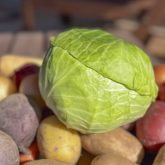Rebekah Sandford’s family and friends spent an entire day last year planting 28,000 garlic plants by hand.
Her farm has risen to 40,000 plants in a season. Even for them though, the farmer mused, that 24-hour planting blitz was a bit busier than she would have preferred.
WHY IT MATTERS: Locally grown garlic is fresher and is supposed to come with a longer shelf life.
Read Also

Your best (and easiest) holiday dainty tray
Make-ahead recipes, store-bought goodies and co-operation with friends and family: Here’s how to throw together a stunning, low-stress tray.
Sandford owns Prairie Winds Garlic Farm near St. Malo, Man.
She’s among the relatively few farmers who have broken into the industry without a farm background. She discovered a love for growing her chosen crop during a visit to a friend about nine years ago.
“I started with one pound of garlic, and I became addicted to growing it,” she said. “The flavour surpassed any grocery store garlic you’d ever find.”
She hasn’t looked back since. Today, she plants betwen 500-800 pounds (226-362 kilograms) of garlic each year.
Her first large-scale effort began with seed garlic from British Columbia (an order of 25,000). It took several years for that West Coast variety to adapt to the temperature extremes high and low temperatures of a Prairie climate, so different from the steady temperature that the crop prefers.
“Once it took off, it was a really good seed product,” said Sandford, “but now I keep my own seed every year. I just pick out the best of my crop and use it to replant.”
When Sandford detects that her garlic bulbs are coming out smaller – a sign that the genetics are struggling – she adds in new seed to refresh her crop.
Lately she’s preferred to stay with Manitoba garlic varieties, as they are already well-adapted to local conditions.

Garlic production
Sandford starts off each season in the fall. This is when planting happens, and she draws a crowd to come help.
“It’s like a planting party day where we have it all organized; we plant it all together and then we do a big barbecue at the end of the evening,” she said.
For this 2025 growing season, her 28,000 plants are split into 25 rows. The farm uses a dibbler to ensure even spacing – essentially a series of spikes on a drum shape – to poke holes into the soil where each seed can be placed by hand.
Once this is done, she adds a six-inch layer of straw over the plants to protect the garlic from the winter cold. Once spring returns, the straw has the added benefit of keeping weed pressure down.
Sandford also uses a rotation cycle to keep disease from taking hold in her garlic crop.
“Every four years, we do a garlic rotation. So, you don’t plant in the same spot every year,” she said.
“It would surprise a lot of people that garlic is very susceptible to disease, even though garlic is very beneficial to our bodies,” she added. “In the garlic plant itself, it is combating a lot of issues.”
When a particular garlic plot is in a rest cycle, she uses that space for a variety of vegetables such as potatoes, green beans, sugar snap peas and cucumbers to keep her plots productive.
Sandford also taps organic methods for her garlic. Fertilizer comes in the form of a foliar spray of a fish emulsion during the growing season.
When it comes time to harvest, not all varieties peak at the same time.
“Different varieties have different times,” said Sandford. “I’ve harvested as early as July 15. That’s not always standard, but it was a very hot year.
“We generally have a time frame of two weeks between mid-July and early August. If you leave them too long in the ground, the garlic kind of pop out and they want to re-seed themselves.”

Garlic products in plenty
While garlic bulbs make up the majority of what Sandford sells to the public, she also sells pickled garlic cloves and scapes (the plant’s flowering stem), garlic powder, garlic salt and dehydrated granulated garlic.
But one particularly curious product that she makes is black garlic.
The process requires a special electric cooker that Sandford packs with garlic and sets at 72 degrees Celsius for nine days. Once it’s done, the garlic has dramatically changed from pearly white to a deep, brownish black – a process that’s known as the Maillard reaction.
“Some people say it’s kind of like a fermented product, but research has showed it’s technically not fermented,” said Sandford. “It’s just slowly cooked, kind of aged, and it turns it from this sharp, pungent taste to like a sweet, smoky flavour.”
The end result is a molasses-like paste that pairs nicely with a smear of cream cheese on a cracker (as suggested on the jar).
Sandford primarily sells her garlic locally via farmers’ markets and through direct marketing at the farm. A quick look at the farm’s social media shows a loyal following often eager to know when the next garlic crop is ready.
A particular quality her customers appreciate is the freshness of her garlic, she said.
“I would say a lot of customers are tired of buying garlic from the grocery stores. The main complaint is they buy it, and three weeks later, it has no flavour and it’s dried up.”
There’s also the added benefit of a longer shelf life — more than six months if it’s properly stored.
“When you buy local, you’re getting the product fresh out of the gate, and it hasn’t sat in a warehouse for six months already,” she noted.
















